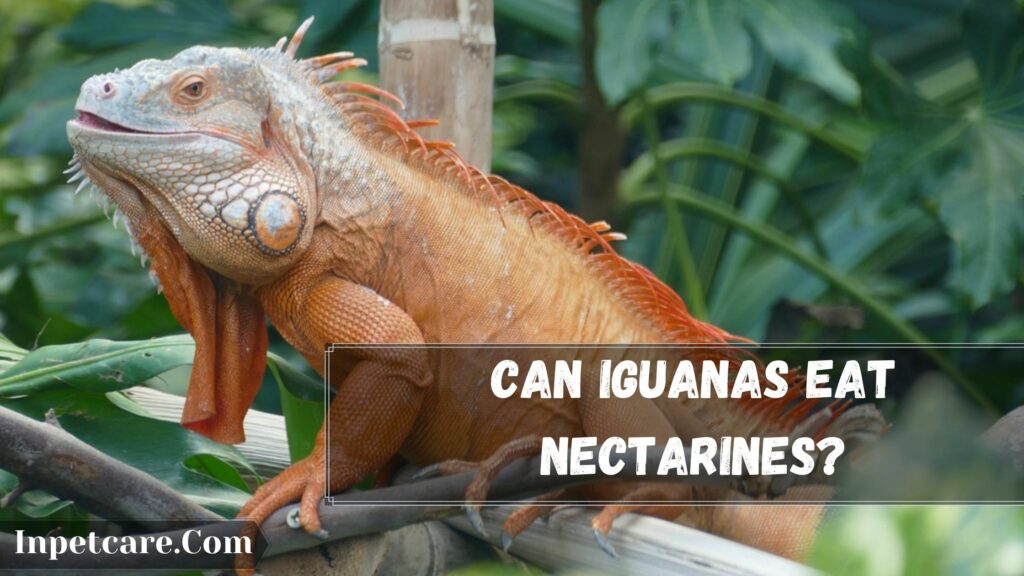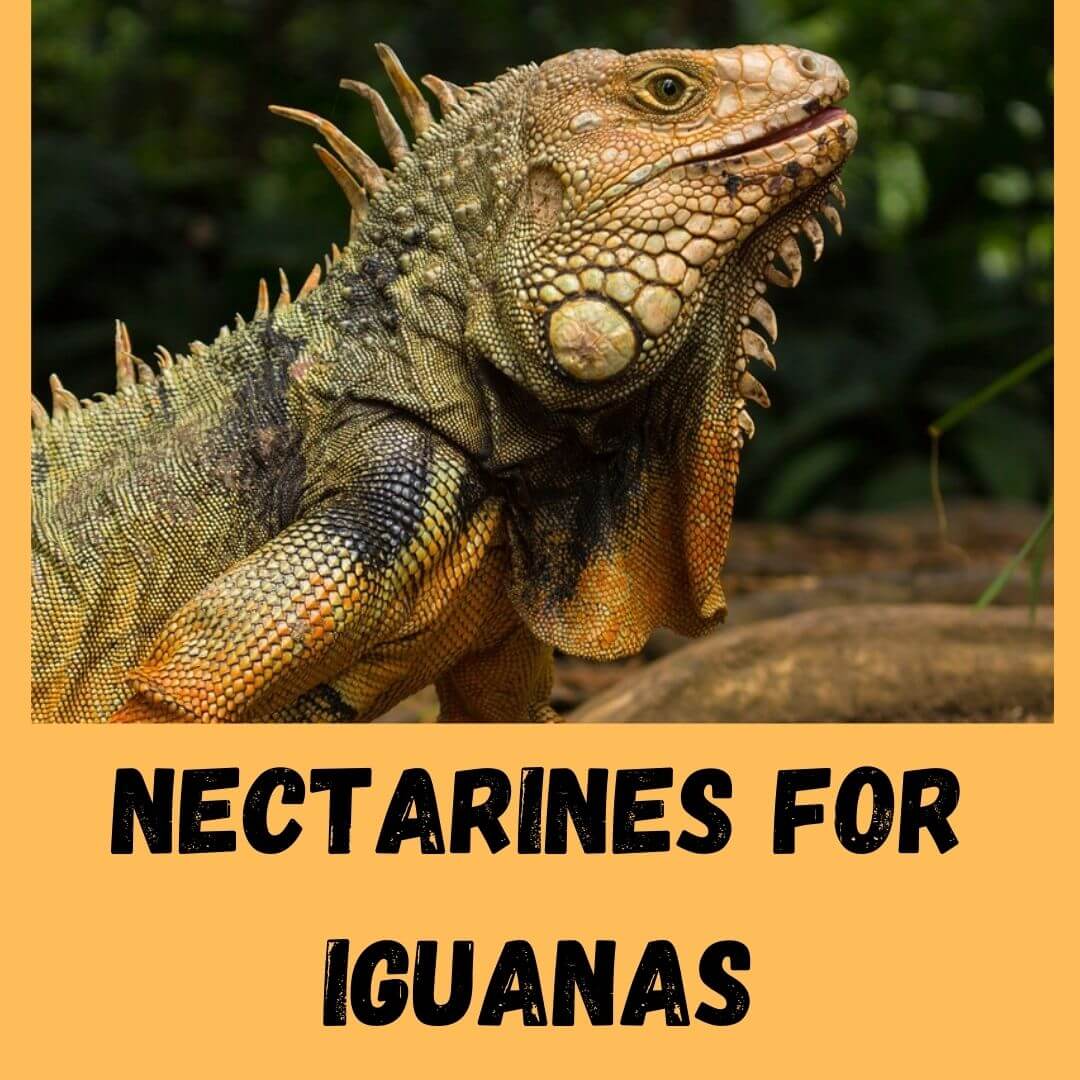If you are looking for the answer to the question: can iguanas eat nectarines? then this article is for you. I will share some hard facts about nectarines for iguanas below.
We all know that nectarine is a peach fruit with thin colour skin and smooth pulp, and it is usually firm and rich in many nutrients. Therefore, it is healthy for humans, but what about reptiles. Can iguanas have nectarines?
Post Contents
Can Iguanas Eat Nectarines?

Yes. Iguanas can eat nectarines on an occasional basis. That is once a twice a month. Due to having poor calcium to Phosphorus ratio, these nectarine fruits should be fed in moderation or ignored.
Many other fruits, including cantaloupe, bananas or peach, can also be given to Iguana once a month but not more than that as these fruits also carry poor calcium to Phosphorus ratios. Any Iguana fruit should be considered a treat and not a primary part of their regular serving.
You should also avoid feeding fruits to hatchlings as it can ve fatal after several weeks of feeding fruits containing lots of seeds. Fruits like figs and raspberries should always be ignored. When it comes to choosing healthy and safe food for Iguana, there are plenty of options that you can consider.
Why Are Nectarines Bad For Iguanas?
When choosing any food, take a look at the calcium to Phosphorus ratio as it’s the essential requirement for any reptile’s wellbeing. The ideal calcium to Phosphorus ratio for Iguana is 2:1. Iguanas are susceptible to diarrhoea when they ingest watery fruits.
Nectarines contain 87.59g of water. So be careful when offering nectarines, peaches or cantaloupe and make sure it is not more than a treat. Iguana should never be fed with any fruit with high acid content as it can cause related health issues.
Even though Nectarines are rich in essential minerals and vitamins that are an essential part of any iguanas diet, the calcium to Phosphorus ratio may interfere with their digestive tract and system. Therefore Nectarines should always be offered in a reasonable amount on an occasional basis.
Calcium is an essential part of any Iguana’s need for healthy growth and the development of healthy bones. Calcium can be given to Iguana only if the Phosphorus is half of the calcium content. Nectarines are also high in vitamin C, which is necessary for iguanas to maintain a healthy immune system and promote their further growth.
But, should you feed Nectarines? of course not. This fruit should always be given once a month in moderation only. Alternatively, it would help if you looked at adding calcium supplements to your Iguana daily serving or salad.
Despite all the essential nutrients and advantages of nectarines, too much of it can be dangerous if fed to iguanas regularly. Disproportionate calcium to Phosphorus ratio is enough to cause calcium deficiency in iguanas.
In addition, the too much water content present in nectarines can result in overhydration which could in turn cause diarrhoea in iguanas. Overhydration and diarrhoea will, in turn, cause dehydration too. This is why nectarine should not be used as a staple food for any reptile, including Iguana.
How to Prepare Nectarines for Iguanas?
Preparing nectarines for Iguana is overall a simple process, but there are a few things that you need to keep in mind, and I want to share them with you. Below are the steps to follow when preparing nectarines to keep your Iguana safe.
Each step needs to be remembered by all responsible reptile owners, and these simple steps can also be fatal if not done correctly.
Step 1: Choose the organic and fresh nectarine.
When you visit the local supermarket, choose fresh and 100% organic fruit. Avoid picking fruits in the wild because you don’t know whether they are safe or not for your Iguana. The nectarines should be fresh and organic free from any chemicals, pesticides or insecticides.
Step 2: Wash the nectarines twice & thoroughly
Whenever you prepare any fruit for your Iguana, it is always best to wash it twice. After grabbing the fruit from your local market, the first thing you should do is wash it right away in your kitchen. The second time you will want to wash the fruit is before feeding it to your Iguana.
Step 3: Peel the fruit
Do you know that some fruit skin carries chemicals even after being washed? Therefore, peeling the peel or skin of any fruit will ensure the safety of your Iguana. Another advantage of peeling the skin is it removes the hard part of the fruit.
Complex parts of any fruit, including nectarines, should permanently be removed as iguanas are not known for chewing thoroughly, making them vulnerable to impaction and choking.
Step 4: Chop Or Mash The Nectarines
After you are done peeling off the nectarines’ skin, you should look to chop it into small bite pieces. Avoid offering any fruit in big chunks as it can cause choking and impaction.
Another advantage of chopping the fruit is that it prevents the picky eaters from choosing the favourite part only of their served salads. It will be best to always mix the fruit with other Greens and veggies, making it colourful and enticing to eat for Iguana.
Step 5: Remove Uneaten Food
Please wait for your iguanas to finish their salad or treat. If there is any uneaten fruit or part of their serving, remove it if they seem uninterested in gobbling them.
Best Foods To Feed Your Iguana

Safe Fruits
Iguanas can eat fruits like peaches, pears, papaya, watermelon bananas, figs, melons, mangoes, guavas, and pineapples. They can also be given berries like mulberry, strawberries, raspberries, and blueberries.
All these fruits should always be chopped into small pieces and must be served as a part of their salad, not as a staple diet. All these fruits are delicious desserts on their own that are a great addition to any Iguana salad or daily serving. Only buy these fruits are they fresh and organic.
Safe Vegetables
Many safe vegetables can be given in the chopped or mashed form to Iguana to swallow. Iguanas love to munch on carrots, zucchini, sweet peppers, green peas, squash, turnips, corn and butter beans. These vegetables are best served in fresh and organic form rather than the canned form.
But, in the winter season, when markets are low on fresh veggies, you can also get frozen and canned vegetables as long as it is free from additives and preservatives.
Safe Greens
Green should be a part of their daily serving or salad. Iguana loves to chew and eat green leafy vegetables like dandelion, collard, hibiscus, mustard, radish, and kale. Plus, they also love romaine lettuce sometimes. It would help if you always went with purchasing a mixed leaf salad with extra diversity for your Iguana.
Interesting Further Reading
- 5 Reasons Why Do Iguanas Bob Their Heads?
- 5 Humane Ways To Dispose Of Dead Iguana
- What Fruits Can Iguanas Eat? 2022 Updated List
Bad Foods To Avoid Feeding Your Iguana
Insects
As Iguanas are strictly herbivorous, they should never be given live insects, meat, or dog/cat food. You should avoid feeding any food high in protein and always stick to a vegetarian diet.
Protein-rich diets for your iguanas can cause disorders with their livers and kidneys over time. Few insects aren’t going to kill your Iguana, but you should still avoid foods containing high protein.
Rotten Fruits, Flowers & Vegetables
- Always avoid offering any fruit high in oxalate as it can interfere with the production of thyroid hormones in Iguanas.
- Make sure to avoid offering plants or flowers that have been sprayed with pesticides or insecticides.
- Vegetables rich in oxalic acid should always be avoided as they can interfere with the calcium absorption in Iguanas.
- Do your proper research before offering any flower to your Iguana, as some flowers like roses or hibiscus need to be prepared with extra care. Rose or hibiscus-like flowers should be washed and kept outside for at least two weeks before offering to your Iguana to climb on or eat.
- Avoid picking just any vegetables from a farm or supermarket because most contain salmonella as they are grown in wet and warm conditions. Always avoid giving any raw sprouts to your Iguana.
Conclusion
You have all the ideas for preparing nectarines for your Iguana. As per my recommendation, I would advise you to avoid feeding nectarine to your pet as it is disproportionate in the calcium to phosphorus ratio.
However, if you still want to feed some, then make sure to limit the quantity and offer that only once or twice a month. Many other safe fruits can be given to Iguana. You can check our other article in which we have mentioned what fruits can Iguanas eat.
If you like this article, then consider sharing. Your one share can help many people know the terrible consequences of feeding nectarines to their pets.

94% of pet owners say their animal pal makes them smile more than once a day. In 2007, I realized that I was made for saving Animals. My father is a Vet, and I think every pet deserves one. I started this blog, “InPetCare”, in 2019 with my father to enlighten a wider audience.
